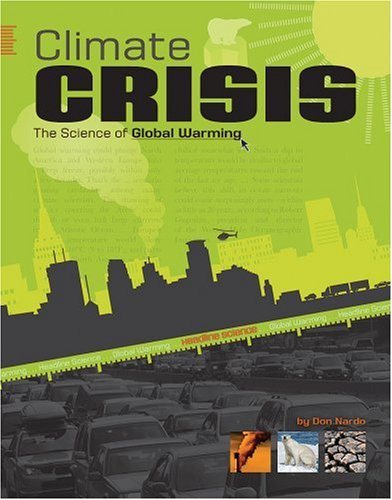

| CLIMATE CRISIS The Science of Global Warming Don Nardo Jennifer Van Voorst (Editor) Mankato, MN: Compass Point Books, September 2008 Grades 5-8 | Reading age: 10-12 | Lexile Measure: 1100L |
Rating: 5.0 High |
|||
| ISBN-13 978-0-7565-3571-1 | ||||
| ISBN 0-7565-3571-9 | 48pp. | HC/FCI | $29.32 | |
This book presents a very basic, but very correct, overview of the overheating we humans are currently causing on the only planet where we can live.
The planet is warming up. The world's living things—plants, animals, and humans—all feel the effects of this global warming. The term global warming refers to increases in the temperature of Earth's atmosphere. Such increases also cause water in the oceans and lakes to grow warmer. – Page 5 |
In five short chapters,1 it lays out what is happening, why it's happening, the likely effects, and possible ways we might turn down the temperature.
But short does not mean superficial. The book is well-researched and comprehensive. It covers such details as the shrinkage of Grinnell Glacier in Montana's Glacier National Park, and the changes in monsoon patterns in Tanzania. The chapters are profusely illustrated with photographs and charts, and each begins with an excerpt from a relevant news story. The chapters are followed by a concise timeline of warming, a Glossary, a Reading List, Notes, and an Index. The content was carefully vetted by educators and scientists including Roberta Johnson, PhD, Director of Education and Outreach at UCAR.
Weather extremes are also caused by increases in the temperature of ocean water. This is best seen in hurricanes. These monster storms thrive on the warmth they draw from the ocean. Simply put, the warmer the water, the more energy a hurricane can pull from it. Some scientists think that they have observed an increase in the intensity of hurricanes that is related to the warmer water temperatures connected with global warming. The number of categories 4 and 5 hurricanes—the biggest and most destructive ones—rose by half between 1970 and the present. These large storms pose a greater threat to human and animal life. They also do extensive damage to cities and towns and erode and alter coastlines.2 – Page 11 |
In short, this is an excellent resource for a student eager to learn about climate change. Full marks.

 To contact Chris Winter, send email to this address.
To contact Chris Winter, send email to this address.